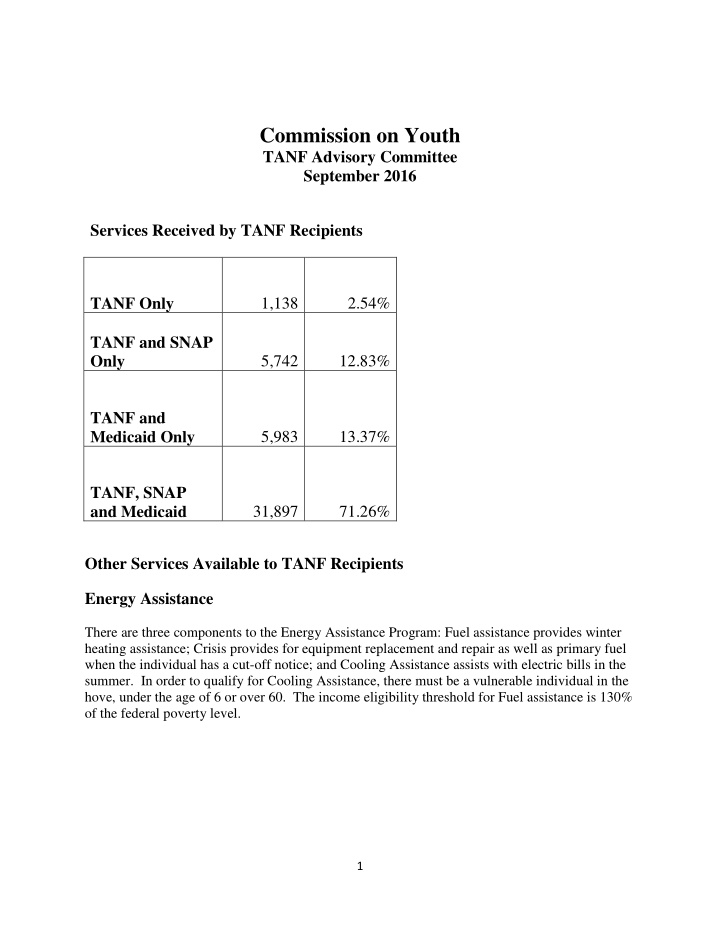



Commission on Youth TANF Advisory Committee September 2016 Services Received by TANF Recipients 1,138 2.54% TANF Only TANF and SNAP Only 5,742 12.83% TANF and 5,983 13.37% Medicaid Only TANF, SNAP 31,897 71.26% and Medicaid Other Services Available to TANF Recipients Energy Assistance There are three components to the Energy Assistance Program: Fuel assistance provides winter heating assistance; Crisis provides for equipment replacement and repair as well as primary fuel when the individual has a cut-off notice; and Cooling Assistance assists with electric bills in the summer. In order to qualify for Cooling Assistance, there must be a vulnerable individual in the hove, under the age of 6 or over 60. The income eligibility threshold for Fuel assistance is 130% of the federal poverty level. 1
Child Care Recipients of TANF (VIEW and non-VIEW) are considered income eligible for child care subsidy and services without a determination of the family’s income eligibility . Women’s Infants and Children (WIC) The program provides nutrition education, breastfeeding promotion and support, supplemental nutritious foods, counseling at WIC clinics, and screening and referrals to other health, welfare, and social services. WIC vouchers allow participants to purchase limited food items: - Baby formula and food - Peanut Butter - Fruits and Vegetables - Juice - Milk, eggs and Cheese - Whole Grains - Legumes - Cereal The WIC income eligibility threshold for a family of three is $37,296 (185% of FPL.) National School Breakfast/Lunch Programs The National School Lunch Program is a federally assisted meal program operating in public and nonprofit private schools and residential child care institutions. It provides nutritionally balanced, low-cost or free lunches to children each school day. The program was established under the National School Lunch Act, signed by President Harry Truman in 1946.Children that receive TANF are automatically certified to receive free school lunch. The School Breakfast Program is a federally assisted meal program operating in public and nonprofit private schools and residential child care institutions. It began as a pilot project in 1966, and was made permanent in 1975. The School Breakfast Program is administered at the Federal level by the Food and Nutrition Service. At the State level, the program is usually administered by State education agencies, which operate the program through agreements with local school food authorities in more than 89,000 schools and institutions. The income eligibility threshold is 130% of poverty for free school breakfast. Children in families between 130% and 185% of poverty may receive reduced price breakfasts for which they pay no more than 30 cents. Housing There are two types of housing assistance. Public Housing - Public housing comes in all sizes and types, from scattered single family houses to high rise apartments for elderly families. Housing Authorities use income limits developed by HUD. HUD sets the lower income limits at 80% and very low income limits at 50% of the median income for the county or metropolitan area in which you choose to live. Income limits vary from area to area so you may be eligible at one Housing Authority but not at another. 2
Housing Vouchers (Section 8) - The housing choice voucher program is the federal government's major program for assisting very low-income families, the elderly, and the disabled to afford decent, safe, and sanitary housing in the private market. Since housing assistance is provided on behalf of the family or individual, participants are able to find their own housing, including single-family homes, townhouses and apartments. The income eligibility threshold for the housing voucher program is 50% of the median income for the county or metropolitan area in which the family chooses to live. By law, a PHA must provide 75 percent of its voucher to applicants whose incomes do not exceed 30 percent of the area median income. Transitional Services A participant, whose TANF financial assistance is terminated either voluntarily or involuntarily, may be eligible to receive the following services for up to twelve months after termination, if needed: Assistance with child care if such assistance enables the individual to work; Assistance with transportation, if such transportation enables the individual to work; Medical assistance, including transitional medical assistance for families with a working parent who becomes ineligible for TANF financial assistance because of increased earnings. Financial assistance of $50 per month, if the participant is employed and is working at least 30 hours per week or more at the time of TANF closure and remains employed and continues to work at least 30 hours per week or more. The Department or local departments may purchase or otherwise acquire motor vehicles from the centralized fleet of motor vehicles controlled by the Commissioner of Highways and sell or otherwise transfer such vehicles to TANF recipients or former recipients. 3
Recommend
More recommend